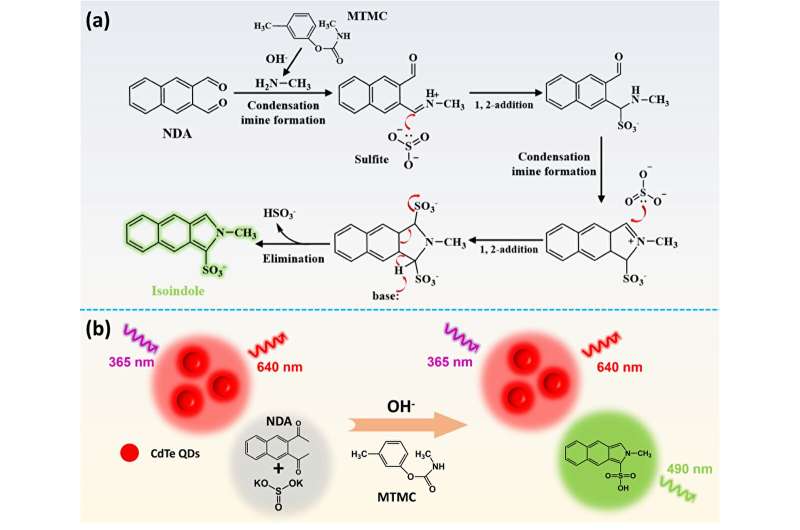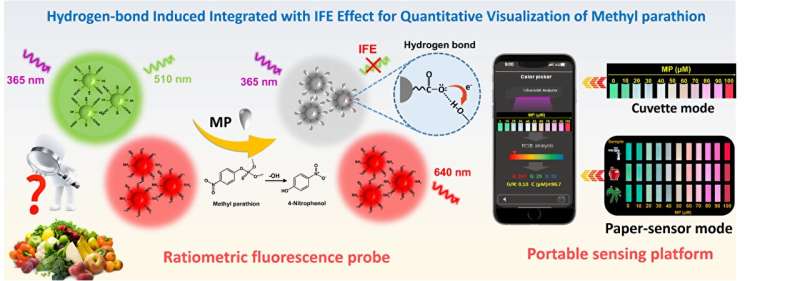This article has been reviewed according to Science X's editorial process and policies. Editors have highlighted the following attributes while ensuring the content's credibility:
fact-checked
trusted source
proofread
Nanoprobe developed for visual quantitative detection of pesticides

Prof. Jiang Changlong's team at the Hefei Institutes of Physical Science of the Chinese Academy of Sciences has developed and synthesized two highly effective ratiometric fluorescence nanoprobes. The nanoprobes were combined with the color recognition function of smartphones to achieve visual quantitative detection of pesticides in food and environmental water.
The study has been published in Chemical Engineering Journal and ACS Sustainable Chemistry & Engineering.
Carbamate compounds and organophosphorus pesticides are widely used in agriculture. Their residues can be found in crops due to their slow degradation in nature. These pesticide residues can enter the body through respiration, skin absorption, or ingestion, posing a serious risk to human organ function and consumer safety.
Currently, the main analytical methods for pesticide residue detection have limitations including high cost, complex operation, and long processing time. Therefore, it is crucial to develop new methods for pesticide detection that are rapid, cost-effective, highly specific, and sensitive.
In this study, the researchers developed an enzyme-free fluorescence probe using CdTe quantum dots as a background fluorescence for the visual detection of carbamate pesticides (CPs). The probe was based on the principle of 2,3-naphthalaldehyde (NDA) and sulfite-induced Strecker reactions.
Upon the addition of CPs, a nucleophilic condensation reaction occurred, resulting in the formation of green fluorescent isoindole. This reaction caused a distinct color change from red to green, allowing for rapid visual detection of carbamates. The probe exhibited a low limit of detection (LOD) of 18.6 nM, which is below the national maximum residue standard.

In addition, a proportional fluorescence probe was developed by combining green carbon dots and CdTe quantum dots for the selective quantitative detection of methyl parathion (MP). Under alkaline conditions, MP was rapidly hydrolyzed to form p-nitrophenol (p-NP). Interaction between the carbon dots and p-NP resulted in quenching of the green fluorescence through hydrogen bond strengthening, resulting in a sensitive color change from green to red. The LOD for MP detection was as low as 8.9 nM.
This work provides a new strategy for the detection of carbamate pesticide residues and organophosphorus pesticide residues, and expands the application of chemically sensitive luminescent materials in environmental protection and food safety, according to the team.
More information: Lingling Qin et al, A Strecker-like reaction triggering fluorescent sensing platform for enzyme-free and visual quantitative monitoring of carbamates, Chemical Engineering Journal (2023). DOI: 10.1016/j.cej.2023.142550
Lingling Qin et al, Ratiometric Fluorescent Sensor Based on Hydrogen-Bond Triggering the Internal Filter Effect for Enzyme-Free and Visual Monitoring Pesticide Residues, ACS Sustainable Chemistry & Engineering (2023). DOI: 10.1021/acssuschemeng.3c00772
Provided by Chinese Academy of Sciences





















